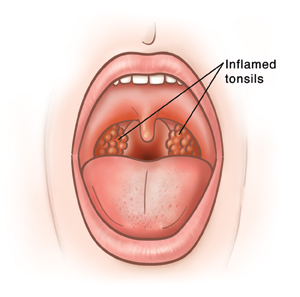You or your child has an infection around the tonsils. This is sometimes caused by the streptococcus bacteria, so it's often called strep throat. The infection can cause severe sore throat, pain with swallowing, swollen glands, and fever.
Strep throat is treated with antibiotics.
Home care
-
All of the antibiotics should be taken as prescribed until they are gone. This is true even if symptoms start to get better. This is very important to ensure that the infection goes away. This helps prevent serious complications. It also helps keep the infection from spreading to other people.
-
Pain medicines should be taken as directed. Talk with a healthcare provider before using over-the-counter (OTC) pain medicines if you or your child has chronic liver or kidney disease, or has ever had a stomach ulcer or gastrointestinal bleeding. Never give ibuprofen to a child less than 6 months old. Don't give aspirin or aspirin-containing medicines to children younger than 18 years. It can cause a serious problem called Reye syndrome.
-
To help ease pain, children older than 6 years and adults can gargle with warm saltwater. This can be done 4 times a day for the first 2 days. Dissolve ¼ to ½ teaspoon of salt in 1 glass of warm water. Gargle with the solution, then spit it out. (Be sure that children don't swallow the saltwater.) Discuss this home care solution with the healthcare provider to find out what solution is best for you or your child.
-
Cool liquids and soft foods may make eating easier for the first few days.
Follow-up care
Follow up with a healthcare provider as advised.
When to get medical care
Call the healthcare provider right away if any of the following occur:
-
Fever (see Fever and children, below)
-
Symptoms that get worse or new symptoms
-
Symptoms that go away and come back
-
Refusing food and drink
-
Trouble opening the mouth
-
Bleeding
-
Rash
-
Swelling or enlarged glands (that look like bumps) in the neck
-
Neck stiffness
Call 911
Call
-
Trouble swallowing
-
Inability to eat or drink
-
Trouble breathing
-
Excessive drooling
Prevention
Here are steps you can take to help prevent an infection:
-
Keep good handwashing habits.
-
Don’t have close contact with people who have sore throats, colds, or other upper respiratory infections.
-
Don’t smoke, and stay away from secondhand smoke.
-
Stay up-to-date with all of your vaccines.
Fever and children
Use a digital thermometer to check your child’s temperature. Don’t use a mercury thermometer. There are different kinds and uses of digital thermometers. They include:
-
Rectal. For children younger than 3 years, a rectal temperature is the most accurate.
-
Forehead (temporal). This works for children age 3 months and older. If a child under 3 months old has signs of illness, this can be used for a first pass. The provider may want to confirm with a rectal temperature.
-
Ear (tympanic). Ear temperatures are accurate after 6 months of age, but not before.
-
Armpit (axillary). This is the least reliable but may be used for a first pass to check a child of any age with signs of illness. The provider may want to confirm with a rectal temperature.
-
Mouth (oral). Don’t use a thermometer in your child’s mouth until they are at least 4 years old.
Use a rectal thermometer with care. Follow the product maker’s directions for correct use. Insert it gently. Label it and make sure it’s not used in the mouth. It may pass on germs from the stool. If you don’t feel OK using a rectal thermometer, ask the healthcare provider what type to use instead. When you talk with any healthcare provider about your child’s fever, tell them which type you used.
Below is when to call the healthcare provider if your child has a fever. Your child’s healthcare provider may give you different numbers. Follow their instructions.
When to call a healthcare provider about your child’s fever
For a baby under 3 months old:
-
First, ask your child’s healthcare provider how you should take the temperature.
-
Rectal or forehead: 100.4°F (38°C) or higher
-
Armpit: 99°F (37.2°C) or higher
-
A fever of ___________as advised by the provider
For a child age 3 months to 36 months (3 years):
-
Rectal or forehead: 102°F (38.9°C) or higher
-
Ear (only for use over age 6 months): 102°F (38.9°C) or higher
-
A fever of ___________ as advised by the provider
In these cases:
-
Armpit temperature of 103°F (39.4°C) or higher in a child of any age
-
Temperature of 104°F (40°C) or higher in a child of any age
-
A fever of ___________ as advised by the provider
Featured in


